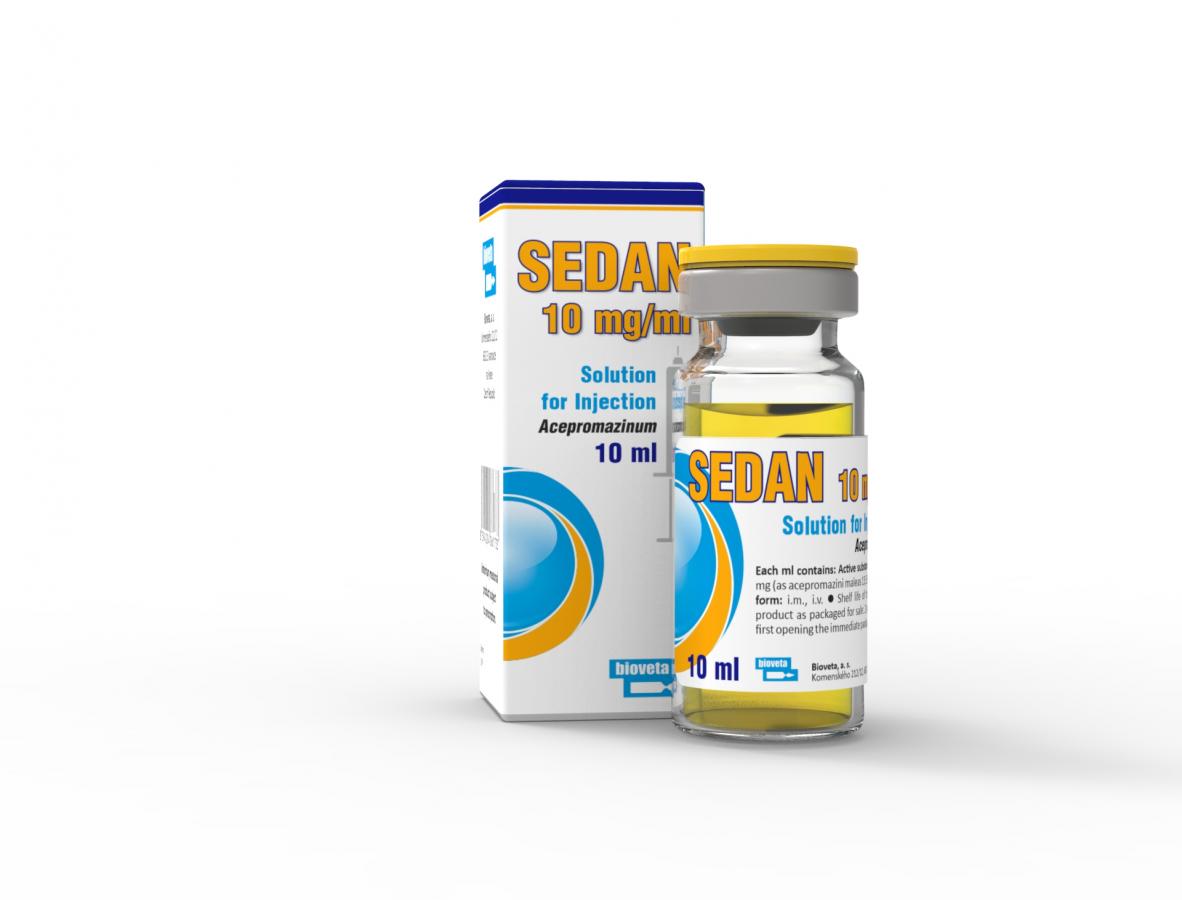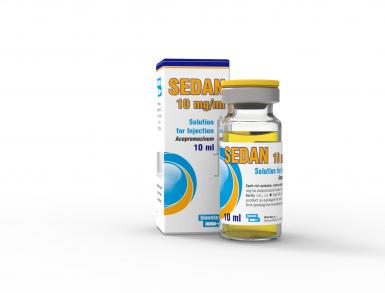SEDAN 10 mg/ml Solution for Injection for Horses
Homepage Products Veterinary products SEDAN 10 mg/ml Solution for Injection for Horses
Suppresses the central nervous system with related action on the autonomous system, has antiemetic, hypothermic, hypotensive and antispasmodic properties and potentiates the effect of barbiturate anaesthesia.
| type of preparative: | Analeptic, anaesthetic, hypnotics |
|---|---|
| target species animals: | Horse |
Statement of the active substances and other ingredients
Each 1 ml contains:
Active substance:
Acepromazine 10 mg (as acepromazine maleate 13.55 mg)
Excipients:
Phenol 3 mg
Orange-yellow solution for injection.
Indications
Anaesthetic premedication: Following acepromazine administration, the amount of anaesthetic necessary to induce anaesthesia is considerably reduced. This reduction is approximately one-third.
Tranquilisation: Acepromazine tranquilisation (ataraxy) involves a reduction of temperament which is not associated with hypnosis, narcosis or marked sedation. This is achieved with low doses of acepromazine. At low doses, acepromazine reduces anxiety, which is beneficial in horses prior to shoeing or transportation.
Sedation: At higher dose rates acepromazine is an effective sedative, as an adjunct to or replacement for physical restraint, e.g. dentistry, handling and shoeing. The relaxant effects aid examination of the penis in horses and the treatment of tetanus and choke.
Contraindications
Do not administer to breeding stallions. Paralysis of the retractor penis muscle has been associated with the use of parenterally administered acepromazine in horses.
Target species
Horses.
Special warnings
Special warnings for each target species:
Do not use in racehorses. Duration of action may be prolonged and this should be remembered when riding, as acepromazine may affect performance and appear in drug tests for some time. Acepromazine has little, if any, analgesic effect so that painful procedures must be avoided, particularly where animals are known to have unpredictable temperaments. Therefore, the usual precautions should be maintained when handling sedated horses.
Special precautions for use in animals:
Situations may arise where general anaesthesia is required in the 4–6 hours following use of the product. In such cases care should be taken to reduce the induction dose of other premedicants and anaesthetic agents, particularly parenteral barbiturates, so as to avoid potentiation and additive depressant effects. Acepromazine is an adrenoceptor blocking drug and this causes hypotension and lowered pressure-controlled ventilation (PCV). The product should therefore be administered with great caution, and at low dose rates only to debilitated horses and animals in states of hypovolaemia, anaemia and shock, or with cardiovascular disease. Rehydration should precede acepromazine administration. Do not, in any circumstances, ride horses within the 36 hours following administration of the product.
Special precautions to be taken by the person administering the veterinary medicinal product to animals:
This product contains a potent sedative, therefore care should be taken when handling and administering this product to avoid accidental self-exposure. In case of accidental self-injection, seek medical advice immediately and show the package leaflet or the label to the physician, but DO NOT DRIVE as sedation and changes in blood pressure may occur. To the physician: Symptomatic treatment may be required. Avoid accidental contact with eyes and skin. If eye contact occurs, flush gently with running water for 15 minutes. In the event of skin contact, wash the contaminated area immediately with large amounts of water and soap. If irritation persists, seek medical advice. Wash hands thoroughly after use.
Pregnancy and lactation:
Do not use during pregnancy and lactation.
Interaction with other medicinal products and other forms of interaction:
Tranquilisers are additive to the actions of other depressants and will potentiate general anaesthesia.
Do not use this product in conjunction with organophosphates or procaine hydrochloride, because it may increase their activity or lead to potential toxicity.
Posology and method of administration
By intramuscular or slow intravenous injection 0.03–0.10 mg acepromazine per kg bodyweight, which is equivalent to 0.15–0.5 ml of the product per 50 kg bodyweight.
Normally, a single dose of acepromazine is administered. Long term use is not recommended. On the rare occasions that repeat dosing is required, the dosing interval should be 36–48 hours.
Special storage precautions
Keep out of the sight and reach of children.
Keep the vial in the carton in order to protect from light.
Protect from frost.
Do not use this veterinary medicinal product after the expiry date which is stated on the packaging. The expiry date refers to the last day of that month.
Shelf life after first opening the immediate packaging: 28 days.
After first opening the immediate packaging, determine the date of disposal of the remaining product in this package, based on the shelf life after first opening which is stated in this package leaflet. Write the date in the space provided on the label.










